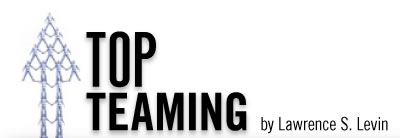Top Teaming: Building and Improving Global Virtual Teams Part 2: How Good Teams Gets Even Better
In our previous Blog, we referenced the difficulty for teams in working virtually across geography, culture, and time. These Global Virtual Teams (GVT’s) are essential in getting work done whether they are at the top of the house or are project/functional teams across the organization. And these teams should bring great promise to the company in their ability to:
- Surface diverse perspectives – of culture, experience, and viewpoints leading to better and more agile business decisions.
- Build a more Gobal and “Glocal” mindset across geographies and regions
- Operate with more Collective Intelligence – the promise being that smart people, operating as TopTeams, should drive results far better than a collection of dispersed individuals.
- Make team members even marter and the business even better.
But do they? Has the promise of GVT’s been realized or are the difficulties in working across distance too significant?
Let’s look at some of the initial leverage points to improve and sustain real teamwork. These are essential beginnings:
1. Know and normalize the issues: Everyone who works virtually understands the difficulties, but rarely do we begin our work together by defining and “normalizing” the issues. In our ongoing work and research with virtual teams, there are some beginnings that must occur:
- Defining the kind of team we need to be. Is this an ongoing team, or a project team that will work together on an issue, then disperse?
- What is this team FOR? What must we accomplish and how interdependent must we be? This speaks to issues of candor and participation. How do we define success?
- How do we define leadership of the team? And what do we require from each other about our participation?
- How do we make decisions? Remember – silence is never true assent.
- What are our agreements about how to play together?
2. How do we work together? This sounds like an obvious question, but time zones of 3/6/12 hours ensure that some populations in the call will lose sleep.
- What is the cadence and rhythm of our calls? How do we balance the discomfort?
- What is the best way to have these calls? Is it a balance of technologies – phone, webinar, skype, telepresence, or an over-reliance on conference calls? How do avoid the “invisible man” syndrome of people who are on the call, but not engaged in dialogue?
- Do we speak the same language well enough to really understand nuance and examples?
- How do we address our cultural differences of assertion, hierarchy, surfacing differences, and candor?
- How often do we meet in person? This varies as to the purpose and permanence of the team. My strong belief is that since trust largely depends on building strong informal relationships, in-person meetings with time to socialize and play together are critical for those teams that must truly think and work interdependently together.
3. How and how often do we assess how we are doing as a Global Virtual Team?
- Do we create a conscious and deliberate process of improvement? Do we assess and ask how we are doing and what will allow us to work even better together? Do we ask for feedback and practice feedforward?
- Do we continually review and re-calibrate this team and actively work to move from divergence to convergence? Do we review our “operating agreements” and practice “after-action reviews” to improve our level of play?
Remember – this is not a team-building event. It is a constant, continuing and intelligent process. As such, it requires thought and maintenance.
In the next Blog, we’ll get into some of the more difficult aspects of working Globally and Virtually including understanding cultural norms and assumptions, defining requisite candor and productive disagreement, and defining true agreement.
Please feel free to add to our conversation.
Larry
Lawrence Levin PhD
Founder & President
The Levin Group LLC
+14043779408
[email protected]
www.TheLevinGroup.com
www.TopTeaming.com
“Top Teams have a looseness about them – a deep and abiding trust that they are in this together”
Author: Top Teaming: A Roadmap for Leadership Teams Navigating the Now, the New, and the Next
